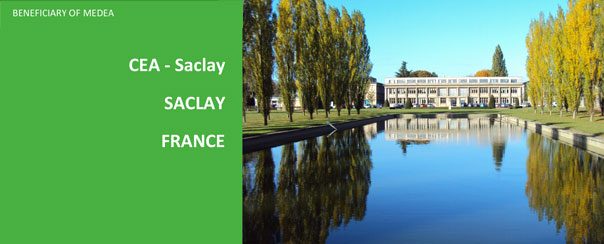Home institution
With 6000 people of which ~600 PhD students, CEA-Saclay is the largest center of CEA, the French Alternative Energies and Atomic Energy Commission (Commissariat à l’énergie atomique et aux énergies alternatives). CEA is a public body established in October 1945 by General de Gaulle, and a leader in research, development and innovation. CEA-Saclay covers a wide range of research activities, from physical and life sciences,to climate and environment, nuclear and technological research but also education. The highly scientific and multi-disciplinary nature of research contributes to the diversity and richness of CEA-Saclay. The many programmes of national, European and international research in which it is involved, and the multitude of contacts it has made with regional industry demonstrate its dynamism and its openness to the outside world.
CEA-Saclay is located within one of the largest concentrations of public scientific institutions, academic bodies as well as private company labs in France. The research environment in physics, from particle physics to physical chemistry, includes several CEA and CNRS units, labs in the academic institutions such as University of Paris-Sud and engineering schools (Ecole Polytechnique, Ecole Nationale Supérieure des Techniques Avancées, Institute of Optics Graduate School, etc.), as well as large scale facilities such as SOLEIL synchrotron radiation and laser labs LULI, LOA, APOLLON and ATTOLAB. The “physicists” population represents about 2500 permanent researchers and as many non permanents.
This so-called “Plateau de Saclay” and its surroundings is an attractive area, mixing high tech science and open green fields, urban resources and charming villages in wooden valleys, all this within a 30’ train connection to Paris. Université Paris-Saclay (www.universite-paris-saclay.fr/en) is now bringing together 19 varied but complementary institutions: 2 universities, 11 prestigious university-level colleges and 7 research organizations (including CEA-Saclay) for establishing as a major scientific pole in Europe. This favours convergence between the different scientific fields, institutions and labs, basic research and R&D, academic and industry. Within the ten forthcoming years, it promises to deeply and positively transform the Saclay area, an already pleasant one to work and to live in, preserving – we all hope – its natural character. The young researchers of the Plateau de Saclay may either prefer the innumerable resources of Paris or the country side surroundings of the labs depending on personalities
Research Training Modules (RTMs)
- Two-source interferometry of high harmonics (see PDF below for details)
- Electron interferometry – RABBIT (see PDF below for details)
- Weveform synthesis for isolated attosecond pulse generation (see PDF below for details)
Address
Laboratory Interactions, Dynamics and Lasers (LIDyL)
CEA-Saclay, Université Paris-Saclay
91191 Gif-sur-Yvette – France
General Contact
http://iramis.cea.fr/LIDyL/en/
caroline.lebe@cea.fr
Scientist in charge
Pascal Salières
+33 1 69 08 63 39
pascal.salieres@cea.fr
